Table of Contents
Introduction:
Electrophoretic Mobility Shift Assay (EMSA) is a widely used technique in molecular biology to study protein-DNA interactions. The assay is based on the principle that proteins can bind to specific regions of DNA and alter its conformation, which in turn affects the mobility of the DNA in an electric field. EMSA is used to study a wide range of biological processes including transcription regulation, DNA repair, and chromatin remodeling.
Principles of Electrophoretic Mobility Shift Assay (EMSA):
- The principle of EMSA is based on the fact that proteins can bind to specific regions of DNA, altering its conformation, which in turn affects its mobility when placed in an electric field.
- Proteins that bind to DNA will form a complex with the DNA, which will have a different electrophoretic mobility than the free DNA.
- By analyzing the mobility of the DNA in the presence and absence of a specific protein, researchers can determine if the protein binds to the DNA and identify the location of the binding site.
Methods of Electrophoretic Mobility Shift Assay (EMSA):
There are several methods of EMSA, but the most common one is the gel shift assay:
Gel shift assay: This method involves running a mixture of DNA and protein on a gel in the presence of an electric field. The DNA will migrate through the gel based on its size and conformation. Proteins that bind to the DNA will form a complex with the DNA, which will have a different electrophoretic mobility than the free DNA. The gel is then stained with ethidium bromide, which intercalates into the DNA and fluoresces under UV light, making the DNA visible.
Applications:
- Transcription regulation: EMSA is used to study how transcription factors bind to specific regions of DNA to regulate gene expression.
- DNA repair: EMSA is used to study how DNA repair proteins recognize and repair damaged DNA.
- Chromatin remodeling: EMSA is used to study how chromatin remodeling proteins modify the structure of chromatin to regulate gene expression.
Advantages:
- EMSA is a sensitive method for detecting protein-DNA interactions.
- It can be used to identify the location of protein binding sites on DNA with high resolution.
- It can also be used to study the dynamics of protein-DNA interactions over time.
Disadvantages:
- EMSA requires purified protein and DNA samples, which can be difficult to obtain.
- It can be labor-intensive and time-consuming.
- The results of EMSA experiments may be affected by the specific conditions used, such as the salt concentration or pH of the buffer.
Conclusion:
EMSA is a powerful technique for studying protein-DNA interactions and has many important applications in molecular biology. It allows researchers to study the binding of transcription factors, DNA repair proteins, and chromatin remodeling proteins to specific regions of DNA. However, it requires careful experimental design and interpretation of results.

